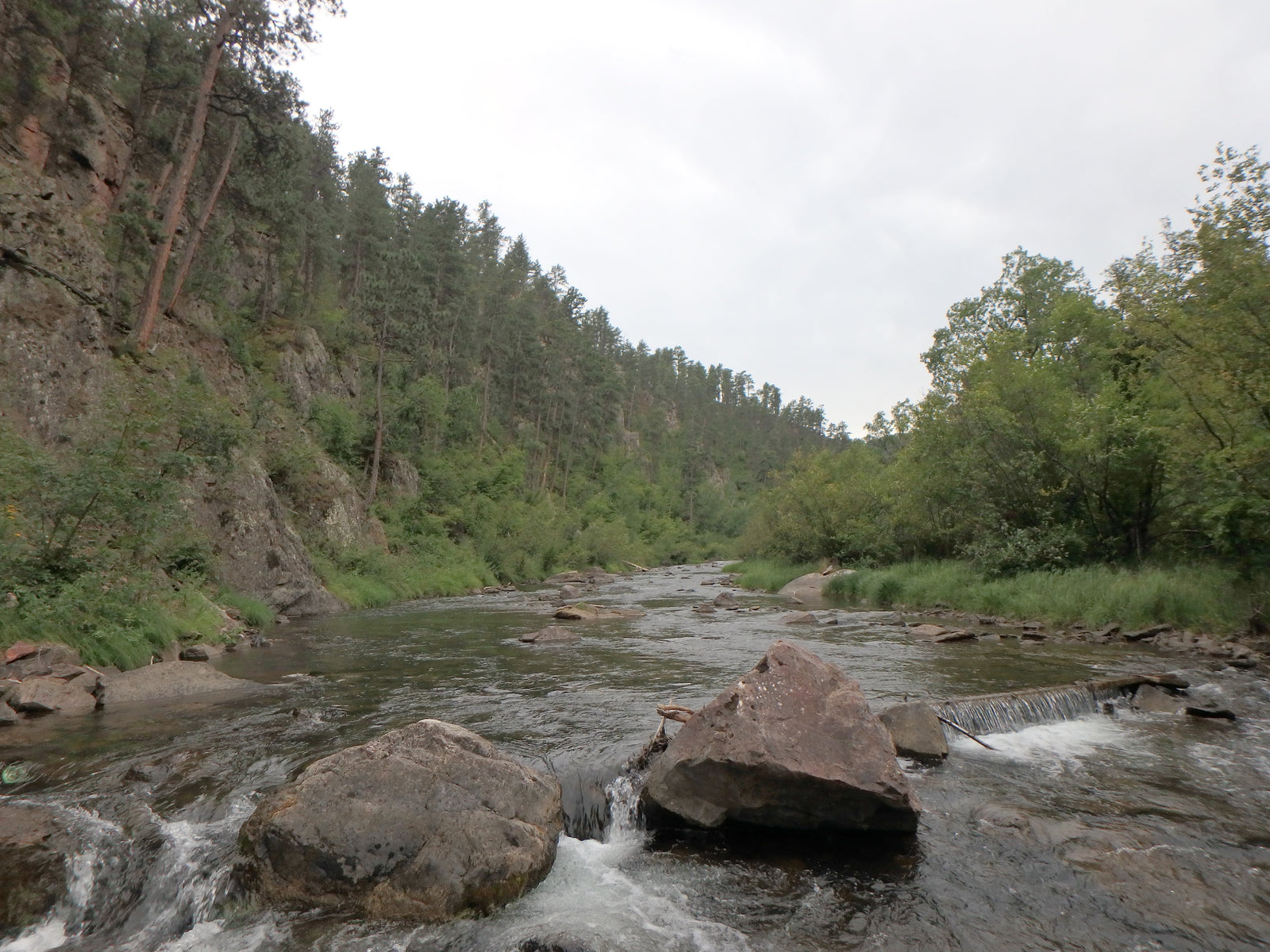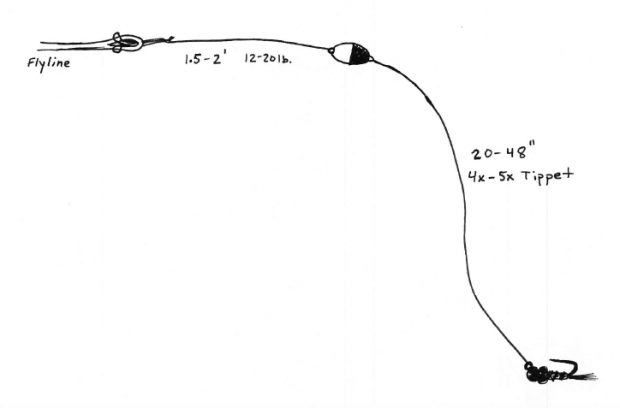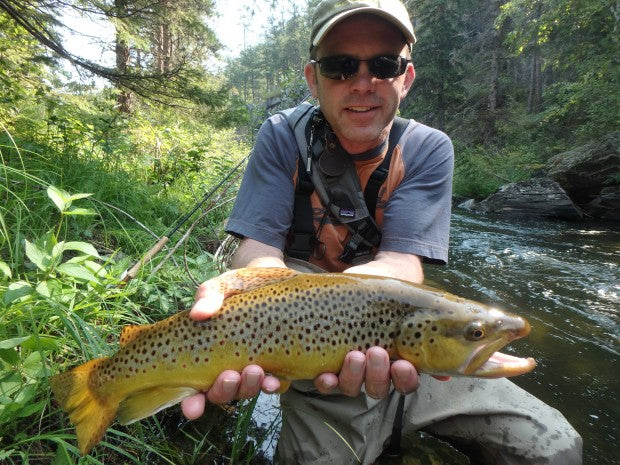High Water Nymphing Rigs and Techniques

Ryan Gabert |
The lower half of this post is from 2015 when we had lots of water also, and we thought it would be helpful for folks this year as well! We have a lot of water in most of our streams this year, and it's a little intimidating compared to the flows we've had over the past couple years. We'll take high water whenever we can get it - it makes the fish much healthier, and helps give us good flows during the hot months of late summer. The fish still have to eat, and as long as there's good visibility - 1' or so - you can catch plenty of fish. The key is using larger/heavier flies than you typically would, as well as fishing the softer edges and water where there's broken current. If the fish can see your flies and you're getting a good drift, you'll do well!
Where should you look for fish when the flows are high? For the most part, forget about fishing the middle of the river. Trout don't want to be on the treadmill out hanging out in the middle, swimming their little tails off trying to just stay put. They'd rather be on the couch, closer to the banks and leisurely swimming around and letting the food come to them. Lots of folks want to wade out until they're 4 or 5 feet off the shore, but if you do that you're walking past 90% of the fish right now. Keep your feet on the bank to start with, and fish anywhere that's over shin deep or so. There high water pushes the vast majority of the fish to the edges, so that's where you should spend most of your time.
Flies? Anything can be fair game when the water is this high, but larger always seems to work better when the water is higher. Mop Flies, Worms, Annelids, and larger, big profile jig nymphs have been the ticket over the past week or so. If the fish can't see it they can't eat it, so don't be afraid to go a little larger than you typically might be comfortable using. Size 10-14 is a good start.
The indicators shown in the diagram below are no longer made, so we've had to change our rig a little bit. Rather than tying your line to the loops on the indicator, tie a 2.5-3mm tippet ring in place of it. Rig the bottom up the same as you would in the below diagram, and loop on a CorQ or AirLock indicator a couple inches above the tippet ring. The setup is identical, just with the tippet ring and indicator in place of the nugget.
In short - don't let the high water scare you off. We've been fishing and guiding quite over the past week and have had some great days. Swing by the shop for some tips and tricks or if you're looking for somewhere to go!
High Water Nymph Rig Post From 2015
Nymphing can be a mystifying game at times. How far should your indicator be from your flies? How far from your weight? How much weight should you use? When fishing nymphs and indicators on a traditional tapered leader style setup, commonly called a "Bighorn Rig", there's a lot of variables that can be left up in the air. We've been fishing and guiding with a much simpler setup that's incredibly effective - here's a breakdown of what we've been throwing!
As I alluded to before, the Easy Nymph Rig doesn't use a tapered leader, so you can take that off your line first. Tie a perfection loop in a piece of heavy mono, loop it onto your fly line, and make it 18"-24" long. We prefer stiff mono like Maxima in 12-20 pound because it helps turn the rig over without the use of a tapered leader. Then, tie on a Strike Foundry Lil' Nugget or full size Nugget on the fluorescent end with a clinch knot. They have a metal loop in both ends which is used for attaching your butt section and tippet, respectively, and are an easy-to-see fluorescent color on one half and a neutral gray color on the other. After attaching the butt section from your fly line to the fluorescent half of the indicator, you tie your tippet onto the loop on the loop on the gray half. We generally make this length 20"-48" for fishing our Black Hills streams, but it can be adjusted as necessary for the depth and speed of water you're fishing. After tying on the proper length of tippet, you simply attach your fly to the end. If you want to use a dropper, that's cool too!
What's the advantage of a rig like this as opposed to a traditional nymph rig on a tapered leader? Sink rate and strike detection are the two biggest advantages. With the level tippet from the indicator to a tungsten fly, it sinks like a rock and gets to full depth in a matter of a couple seconds. With a traditional setup, half of your drift is often wasted waiting for your fly to get down - this equates to wasted fishing time and less fish in your net! Strike detection is the other big advantage. With the easy nymph rig, you have a straight, fairly taut connection to your fly or flies. This translates to seeing the strike almost the instant the fish takes the fly, rather than having to straighten out a tapered leader. This doesn't seem like a huge deal, but in nymph fishing seeing the strike a half-second sooner can mean the difference between a couple fish and a spectacular day.
How do you fish the easy nymph rig? Our favorite way to toss this rig is with a long Czech nymph-style rod. We often keep almost all of our line off the water, just keeping the butt section and the indicator on the surface of the stream. You follow the indicator with your rod, and you almost get a pendulum-like drift. This keeps you at a great angle to set the hook, and you're already pretty taut to the flies which allows you to set the hook very quickly.
All of this means that you get your flies down to the fish quicker, get a significantly better drift, and see your strikes sooner. These things combined equal more fish in your net! This is an incredibly effective setup to fish with, and it's very easy to learn how to do. We've been having spectacular luck on guided trips with this setup, and many of our customers have been really excited about how well it works. Stop by and we can show you how to rig it up - you'll be surprised with how deadly this system can be!
Ryan


